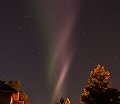|
Aurora Gallery back to spaceweather.com |
| Summary: A coronal mass ejection hurled into space by sunspot 652 (movie) hit Earth's magnetic field on July 26th at approximately 2300 UT. The impact triggered a severe geomagnetic storm that lasted for 12+ hours, sparking auroras as far south as California in the United States. See also the May-June 2004 aurora gallery. Page 1 | Page 2 | Page 3 | Page 4 | Page 5 | Page 6 | This is Page 7 Got
pictures? Submit
them. |
| Photographer, Location | Images | Comments | |
|
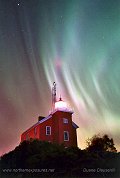
|
Duane Clausen,
Marquette, Michigan Jul. 25 |
#1, more |
This image of the historic Marquette Lighthouse was taken in the predawn hours of Sunday July 25th in Marquette Michigan. |
|
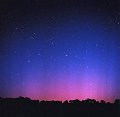
|
Dirk
Obudzinski, Lake Berryessa, California, USA Jul. 27 |
#1, #2, #3, #4, more | Images #3 and #4 showing the 'brightest' moments near 4 AM (11:00 UTC) on July 27, as auroral activity intensified somewhat. At that time I noticed a few very faint, but tall rays in the East(!) nearby the rising Venus, as seen in image #1. The Pleiades and the constellation Taurus can also be seen in that picture. Image #2 was captured at 1:48 AM displaying a small meteor next to the aurora. |
|

|
Stan
Richard, Saylorville Lake north of Des Moines, Iowa Jul. 26 |
#1, #2, #3, #4, more | Hare are a few shots of a substorm I witnessed Monday evening just after dusk. For a brief period there were 2 green arcs, one directly overhead with beams extending from the lower arc almost to zenith, quite beautiful. It faded out quickly. I used a Canon Digital Rebel for these. |
|
|
David
Johnston, Duvall, Washington, USA Jul. 27 |
#1, #2, #3, #4, more | What a colorful evening! Photo #3 is a panorama of six photos (6-sec each) to capture the entire East/North/West view (the orange is from city sodium vapor lights). Photo #2 is of the same 'tister' phenomenon seen by Tom Gwilym (gallery page 6) from Renton. The streak he saw to the 'North' was directly over my house. I used a Nikon D1X, ISO 800. |
|
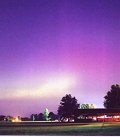
|
Mark
A. Brown, St. Jacob, Illinois Jul. 26 |
#1, #2 | The auroral show at our latitude was very subtle and short lived, but still worth losing some sleep to wait and watch for. Photographed with a Minolta SRT 202 and Fuji 800 film. 20 second exposures at f/3.5 |
|
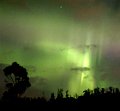
|
Shevill
Mathers, Cambridge, Tasmania, Australia Jul. 27 |
#1, #2, #3, more | These images were taken when there was little visible activity and the camera was much more sensitive. StellaCam EX Video camera showed high speed vertical pulses over a long period, invisible to the naked eye. |
|
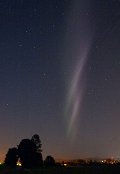
|
Liem
Bahneman, Taken from near Arlington, Washington. Jul. 26 |
#1, #2, more | Yet another Canon Digital Rebel, kit lens. ISO400, f/8 manual timing. Prominent hydrogen arc, with active rays, curtains. Faded into the north, but a bright arc appeared overhead near midnight, with a neat braided illusion. |
|
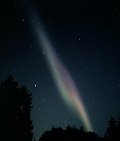
|
Ray
Gilmore, Gig Harbor, Washington Jul. 27 |
#1, #2, #3, #4 | One of the most interesting aurora displays we have seen. Shapes, colors and dimensions changed considerably over a two hour period from 11:30pm PDT. Camera: Canon FTb, ASA 800, 28mm lens at F4, 20 - 30 second exposure. |
|
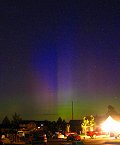
|
Steven
J. Denfeld, Bend, Oregon, USA Jul. 27 |
#1, #2 | This display in the High Desert of Central Oregon peaked sharply just after 1:30 a.m. I observed horizontal sheets of light streaking towards me in very rapid succession - often with less than a second between pulses - which caused the rays to greatly intensify. This was a phenomenon I have never seen before. There was not much color visible except for a slight pink towards the NW. To top off this fine show, there were quite a few meteors streaking through the sky. Images made with a Canon PowerShot S45, 15 sec exposures at ISO 400. |
|

|
Bart
Firth, Dawsonville, northern New Brunswick, Canada Jul. 26 |
#1, #2, #3 | Kodak camera, 400asa, 16 second exposure. One of the best displays of auroras I have seen in years. |
|
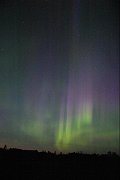
|
John
Ridley, Eagle Harbor, Michigan, USA Jul. 24 |
#1, more | Canon digital rebel, ISO3200, check embedded EXIF info for precise exposure data. No photo can do justice to this aurora; it was incredibly active; I pushed to 3200 to reduce exposure time to 4 seconds, but even so the aurora was moving too fast to really catch the detail that was visible to the eye. Streamers were moving and fading in just a second or two, plus there were fainter background waves that moved completely across the sky in just a few seconds. This site has absolutely NO light pollution; it's on the shore of lake superior in Michigan's upper peninsula, wide-field photos of the sky show NO light domes anywhere, so everything you see here is aurora! |
more images:
from Art Kunz near Carbondale,
Illinois


